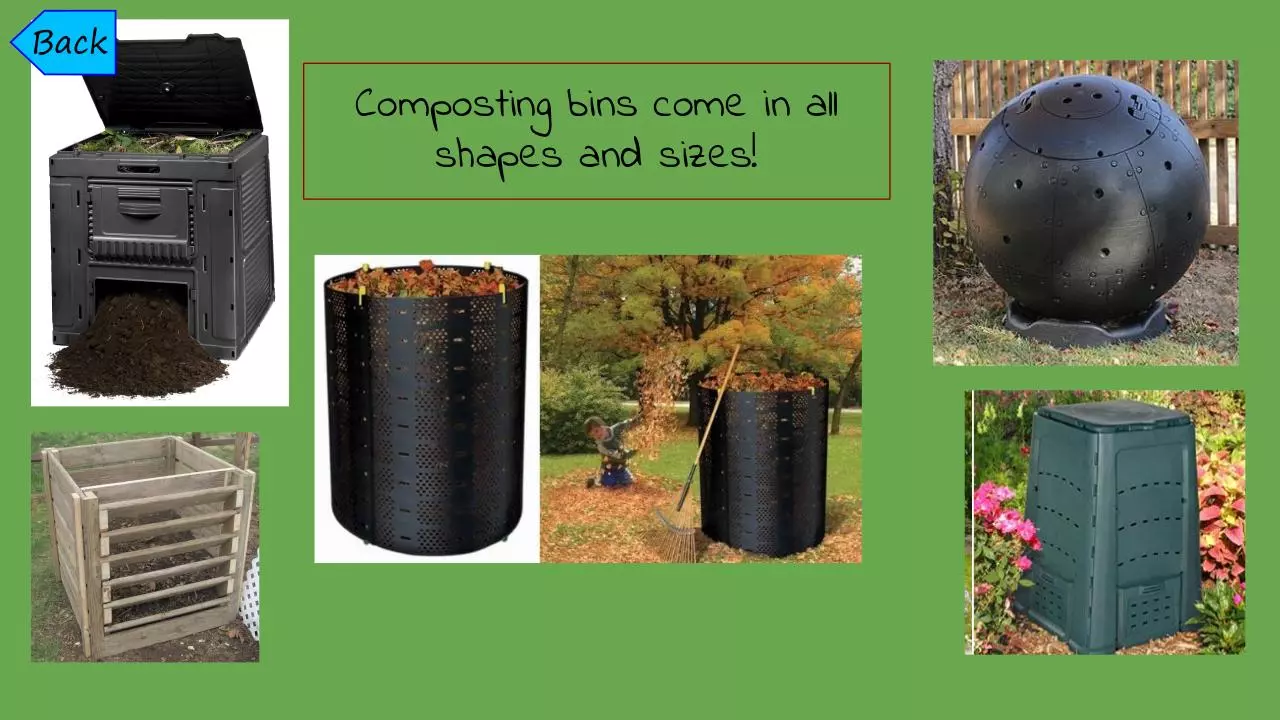ReduceWaste Compost (PDF)
File information
Title: Reduce Waste - Compost
Author: Elvena Bielecki
This PDF 1.6 document has been generated by Google / , and has been sent on pdf-archive.com on 25/04/2017 at 18:04, from IP address 108.49.x.x.
The current document download page has been viewed 409 times.
File size: 2.35 MB (9 pages).
Privacy: public file





File preview
Reduce Waste: Compost
Turn Garbage spoils into black gold soil!
By Elvena Bielecki
What is composting?
How to compost
Indoor Composting with a Worm Bin
Types of bins
Troubleshooting Tips
Citations
Sources
Citations and
and Sources
Why is it important?
Back
What is composting?
What to
compost
●
leaves
●
grass clippings
●
manure (cow,
horse, chicken,
rabbit, NOT
HUMAN or
house pets)
●
food scraps
●
fruit wastes
●
straw/hay
●
coffee grounds
●
hair, lint
Compost is a mixture of decayed or decaying organic matter used
to fertilize soil. Decaying organic matter is most commonly made
up of grass clippings, and fruit and vegetable scraps. Composting
is a simple and efficient way to help make the world a cleaner
place in your own lives. Although composting is a great way to get
rid of excess food scraps, it is also important to be aware that not
ALL items/materials can be composted.
What NOT to
compost
●
weeds
●
wood ashes
●
meat, grease,
bones
●
any dairy products
●
plastic, metal,
glass
●
large amounts of
soggy materials
●
any wood material
●
lime
●
barbecue charcoal
Back
How to Compost: It starts in your own home
A step by step guide:
1.
2.
3.
4.
5.
Have a place in your kitchen for holding your compost temporarily until you are able to
take it out and deposit into your bin (you can put the food scraps you have left right after
your meal (see what is composting for more information)).
Get a bin where you can put your composting materials outside that is close by to your
house to easily walk to.
Fill the bottom of your bin with dry leaves, or twigs and straw(around 3-4 inches deep).
Put another layer of dry material when you have about 2-3 inches of a layer of compost,
you should not be able to see the dry material underneath.)
Repeat steps 3 and 4 until your bin is full. By the time your bin is full, you will find rich
and organic soil that you will be able to use for your garden, lawn, or other purposes.
Back
There is lots of variety when it comes to getting a bin!
*For whatever compost bin you decide on getting, make sure it has air holes so oxygen can get through
Turning Bins
Indoor Bin
Earth Machine
Back
Composting bins come in all
shapes and sizes!
Back
Indoor Composting with a Worm Bin
●
●
●
●
●
Advantages
○
you don’t need to go outside
○
You don’t turn bin contents, the worms turn it!
Bin Type
○
Wood or plastic
○
Size: one square foot of bin surface area for each pound of compost waste created in one week
○
Have holes in bin for air flow
○
Have holes in bottom to let liquid drain out
○
Worms like temperatures between 50 and 60 degrees
Worm type
○
Most common is red wriggler (Eisenea fetida)
○
Ideal ratio is 2:1, so for half pound of compost waste per day, use one pound of worms (1,000 worms in one
pound).
Worm Menu
○
Decaying fruit, vegetables, and bacteria
○
Collect compostable waste in a covered container
○
Add food to ⅓ of the bin every 5-7 days
○
Add food to different row each time
○
Add just a few handfuls each time
Bin bedding
○
Shredded newspaper, office paper, cardboard, partially degraded leaves. Wet with water. When you
squeeze bedding, only few drops should come out. Fill ¾ of bin with moist bedding.
○
Sprinkle in a handful of eggshells or soil. This provides grit to help the worms’ digestion. Handfuls of
completed compost of soil can speed the degradation process. Takes 4-6 months till composting is
completed.
Back
Troubleshooting Tips
Problem
●
●
Slow Decomposing
Fruit Flies
Reasons
Solution
●
●
●
Lack of moisture
Insufficient nitrogen
Too much or too little
mass
Poor aeration
Cold weather
●
Most common pest in bin
●
●
●
●
●
●
●
●
●
●
Odors
●
Bin material are too wet
●
Add water: a fast decomposing pile contains
40-60% H2O, handful of composting material
should feel damp like a wrung out sponge.
Material should be 1 part nitrogen(green) to 3
parts carbon(brown). Add more(green) nitrogen
material
Best pile size is 3-5 cubic feet
Turning pile puts in fresh oxygen or insert
aeration tubes
To improve heat retention, increase pile size,
insulate outer edges of pile w/thick layers of
straw, leaves, or sod. Cover it with a tarp.
Bury food waste 2” below bedding. Use bin
w/air holes too small for flies to get through
Stop putting food waste in bin for 3
weeks--worms can survive over a month,
but fruit flies cannot
Add more dry bedding if more than a few
drops can be squeezed out. Turn pile.
Back
Why is composting important?
There is too much waste product and not enough fresh soil for planting.
Composting is a controlled decomposition of organic material. It reduces
garbage in landfills and creates nutrient-rich soil for gardens and lawns.
Composting is beneficial to our environment and is something everyone can
do!
Back
Citations/Sources
(for reference and/or more info)
What is composting?
http://www.recycleworks.org/compost/
http://www.planetnatural.com/composting-101/how-it-works/
Everything You Always Wanted to Know about Home Composting but Were Afraid to Ask , by New York State Department of Environmental
Conservatory
How to Compost.
http://eartheasy.com/grow_compost.html
http://www.howtocompost.org/
The Complete Idiot's Guide to Composting by Chris McLaughlin
Composting for Dummies by Cathy Cromell and editors of the National Gardening Association
http://www.planetnatural.com/composting-101/how-it-works/
Compost: growing gardens from your garbage by Linda Glaser
Home Composting: A Guide for composting yard and food waste, published by the Commonwealth of MA Executive Office of Environmental Affairs,
Department of Environmental Protection
Home Composting Made Easy, by C. MacDowell, Ph.D. & Tricia Clark-MacDowell
Importance of composting:
http://www.earthtimes.org/going-green/importance-composting-help-eliminate-organic-waste-fertilize-soil/82/
http://compost.css.cornell.edu/why.html
Easy Compost: the secret to great soil and spectacular plants by Beth Hanson
Let It Rot!: the gardener's guide to Composting by Stu Campbell
Download ReduceWaste-Compost
ReduceWaste-Compost.pdf (PDF, 2.35 MB)
Download PDF
Share this file on social networks
Link to this page
Permanent link
Use the permanent link to the download page to share your document on Facebook, Twitter, LinkedIn, or directly with a contact by e-Mail, Messenger, Whatsapp, Line..
Short link
Use the short link to share your document on Twitter or by text message (SMS)
HTML Code
Copy the following HTML code to share your document on a Website or Blog
QR Code to this page

This file has been shared publicly by a user of PDF Archive.
Document ID: 0000588396.